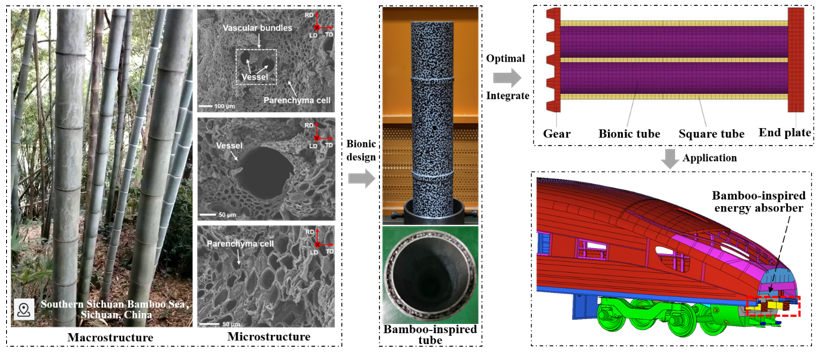Video Article Open Access
Bamboo-inspired Energy Absorber and its Application in Rail Vehicles
Kai Liu#, Zhenhao Yu, Lin Jing*, Kaiyun Wang
State Key Laboratory of Traction Power, Southwest Jiaotong University, Chengdu 610031, China
Vid. Proc. Adv. Mater., Volume 3, Article ID 2208333 (2022)
DOI: 10.5185/vpoam.2022.08333
Publication Date (Web): 22 Dec 2022
Copyright © IAAM
Graphical Abstract

Abstract
Collision passive safety of rail vehicles has attracted increasing concern from the public society due to the continuous development of rail transportation, especially the increasing operation speed of high-speed trains. Inspired by macro and microstructures of bamboo culm with highly efficient energy absorption capability, a novel type of energy absorber was developed in this study, aiming to enhance the energy absorption capacity and crashworthiness of the front part of vehicles, and further the passive safety performance of entire vehicles. Firstly, the low-velocity impact response of bamboo culms with various growth ages under drop-weight impact was experimentally investigated, and the typical deformation/failure pattern, load-displacement response, strain field distribution, energy absorption characteristics, and crashworthiness of dynamically loaded bamboo culms were presented and discussed. The corresponding crashworthiness indices were compared with related energy-absorbing materials and structures. Secondly, a new type of thin-walled circular metal tube inspired by bamboo culm based on its energy absorption characteristics and crashworthiness was proposed and designed. The axial crushing behavior and crashworthiness of the bamboo-inspired bionic tube were experimentally and numerically investigated, compared to the traditional metal tubes. The typical crushing responses (e.g., deformation mode, load-displacement response, energy absorption, and strain distribution) and quantitative crashworthiness indices (EA, SEA, FP, Fm, and CFE) of them were presented and discussed. Then, taking the best crashworthiness indices as the optimization objective, a multi-objective design optimization (MDO) was performed for the developed bamboo-inspired circular tube under the drop-weight impact, and the corresponding Pareto fronts representing a group of best trade-off designs were obtained. Finally, the bamboo-inspired energy-absorbing device was developed by introducing the optimized bamboo-inspired circular tubes, which was then integrated with an eight-car marshaling train collision finite element (FE) model. The structural responses and crashworthiness of rail vehicles under different collision scenarios were discussed and compared with that of vehicles mounting conventional energy-absorbing device. The dissipation mechanism of crash energy between each component and carriage was also clarified under the action of the bamboo-inspired energy-absorbing structure.
Keywords
Bamboo culm; bamboo-inspired energy absorber; crashworthiness; optimal design; rail vehicles.
Acknowledgement
This work was supported by the National Natural Science Foundation of China (Grant no. 12122211).
Biography
Kai Liu (Male, born on November 29, 1993) is a registered student at State Key Laboratory of Traction Power, Southwest Jiaotong University, China, where he is studying Ph.D. in Vehicle Engineering. He is engaged in studying on dynamic mechanical behavior of engineering materials, impact dynamics, and structural crashworthiness. He has participated in 5 projects sponsored by the National Natural Science Foundation of China, including the National Key Research and Development Program and Outstanding Youth Science Foundation projects. He has published 5 SCI and 3 EI papers as the first (second if the supervisor is the first) author and received 2 granted national invention patents and 1 Australian innovation patent. He was awarded the first prize of Science and Technology Progress Award in China Communications and Transportation Association, Schaeffler engineering scholarship, national scholarship, as well as outstanding master's thesis of Southwest Jiaotong University.
Video Proceedings of Advanced Materials

Upcoming Congress



